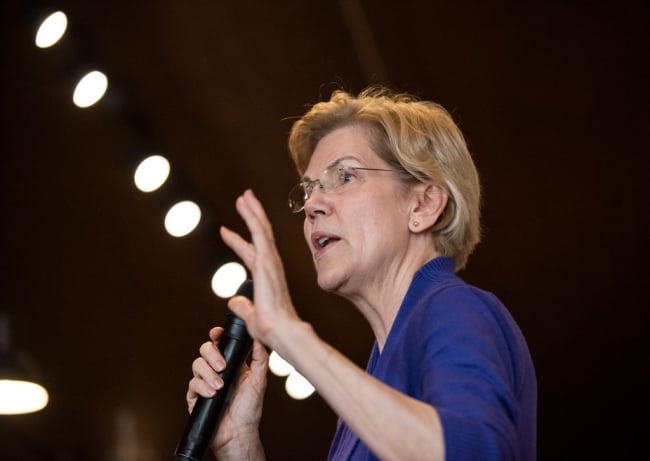You have /5 articles left.
Sign up for a free account or log in.

Senator Elizabeth Warren
Getty Images
Elizabeth Warren’s proposal to cancel most student debt stirred a debate over whether a progressive agenda should include debt cancellation -- and, if so, who should get relief.
But the plan is also notable for offering the most substantive attempt yet by a presidential campaign to address deep racial disparities involving student debt.
As Warren wrote in a Medium post announcing her plan, black college students are more likely to need student loans to attend college and, because of factors like employment discrimination, to owe more than their original balance 12 years after graduation.
“We must do more to correct these historical injustices and to ensure that opportunities are fairly available to everyone,” she wrote.
The proposal calls for canceling up to $50,000 in loan debt for borrowers with household incomes of up to $100,000 and graduated debt forgiveness for those with six-figure incomes up to $250,000. That debt relief would be based on income levels, but her campaign released projections showing that 80 percent of black households with student debt and 83 percent of Latinx households with student debt would receive full loan cancellation under the plan; 73 percent of white households would receive full cancellation, based on analysis provided by the campaign. Over all, 95 percent of Americans with student debt would get some relief, and three-quarters of borrowers would get full loan forgiveness, the campaign said.
Warren is the first among 2020 presidential candidates to offer a comprehensive plan for college affordability and student debt. While past presidential campaign proposals have included funding, for example, for historically black institutions, hers emphasizes potential benefits for borrowers of color.
There’s considerable disagreement among higher ed experts about the details of Warren’s plan. But there also appears to be a growing sense that bold action is required on student debt generally and racial disparities in particular.
“One of the things it gets right is actually focusing on the fact that there is a racial wealth gap and a racial difference in student borrowing and the ability to repay,” said Dominique Baker, an assistant professor of education policy at Southern Methodist University who studies how decisions on student aid and other policies affect underrepresented students.
That racial wealth gap problem has been underlined by emerging federal data and accompanying research in recent years.
Nearly half of black borrowers who entered college in the 2003-04 academic year had defaulted on at least one student loan 12 years later, an analysis of federal data released in 2017 showed. And the typical black borrower from that cohort owed more on his or her student loan 12 years after entering college than he or she originally borrowed, according to another analysis of the same data.
Subsequent research in 2018 controlling for student and family backgrounds like parental wealth has found large differences in the student loan default rates for black and white borrowers. And another study last year found that racial disparities in student debt levels don’t decline after borrowers graduate and enter the work force -- they actually increase throughout the early adulthood of debt holders.
It’s notable that the Warren campaign released an analysis of what debt cancellation would mean for racial groups as well as different income brackets, said Judith Scott-Clayton, an associate professor of economics and education at Teachers College at Columbia University who has studied the racial patterns of student loan defaults.
“They’re definitely not the same patterns, and I think it’s important that they’re attuned to that,” she said. “Just because somebody has a B.A. or even a master’s degree, just because they have a job and they’re making payments on their loans, that doesn’t mean that there’s not real financial strain.”
Louise Seamster, a postdoctoral teaching associate in the University of Tennessee’s department of sociology and one of the academics who contributed analysis of the Warren proposal to the campaign, has also added to the growing volume of research on student debt and the racial wealth gap. In a 2017 paper with co-author Raphael Charron-Chenier, she found most household debt shrank in the post-financial crisis recovery -- with the exception of student debt. And for black families in particular, average student debt grew quickly. By 2013, black households held three times as much student debt as they had 12 years earlier.
Student loans also made up a larger share of debt held by households headed by black Americans than by their white counterparts. Those loans made up 20 percent of black households’ debt in 2013 compared to 6 percent in 2001. For white households, it was 8 percent in 2013 and 4 percent in 2001. But black student borrowers see fewer returns for that educational investment, fitting into a pattern the researchers call predatory inclusion.
“The black middle class is in a really different position than the white middle class,” Seamster said. “Their economic mobility is a lot more precarious.”
That’s not just because of the debt they take on but the way it combines with lower household wealth, she said.
Warren’s plan has taken criticism from higher ed policy circles for not being targeted enough to the borrowers struggling the most with student debt. Adam Looney, director of the Center on Regulation and Markets at the Brookings Institution, wrote in a blog post that the top 20 percent of households by income would receive 27 percent of savings under the plan and the top 40 percent of households would receive two-thirds of savings loan relief under the plan.
“Despite her best intentions and her description of the plan as progressive, a quick analysis finds the Warren proposal to be regressive, expensive and full of uncertainties,” Looney wrote.
Seamster said the researchers who assessed Warren’s plan looked at various thresholds for student debt cancellation and found her proposal would create the most total debt forgiveness for low-income borrowers. She added that the track record isn’t strong for programs designed to help the worst off.
“If you don’t have larger buy-in, the programs are going to be anemic,” Seamster said.
One challenge for researchers looking to assess the plan’s impact on student loan disparities? Available federal data on borrowing by race is limited.
And the Department of Education only recently began releasing data on long-term outcomes for student borrowers, including borrowers of color. The federal government released data in 2017 on borrowers who began college in 2003-04, but outcomes for students who began their postsecondary education since then aren’t available.
The Warren plan relies on the Survey of Consumer Finances, which offers a representative sample of U.S. households but isn’t backed up by administrative data. The survey relies on estimates from borrowers themselves. It also undercounts independent adults; about 30 percent of borrowers may be left out of the survey, many of them low-balance borrowers who may be struggling to repay student debt without a degree.
“We’re understating the experiences of these people, and, frankly, we do that all the time,” said Colleen Campbell, director for postsecondary education at the Center for American Progress, a center-left think tank.
She said translating campaign proposals to actual policy would require better data on the actual composition of student borrowers. Campbell said proposals to reduce debt should also recognize how much of the wealth gap is driven by factors other than student debt.
“The goal should be to reduce the racial wealth gap as much as possible through student debt,” she said. “We also have to keep in mind that the racial wealth gap doesn’t just exist because of debt. We need to take into account the fact that work power has declined, that wages have stagnated, that people don’t have the opportunity to enroll in high-quality institutions.”
Warren's higher ed plan also proposed free public college and other measures that experts said could reduce inequality, like a proposed $50 billion fund for historically black colleges and expansion of Pell Grants. But new findings on student debt burdens for many borrowers have led even some researchers who were previously skeptical of debt cancellation to take seriously some form of automatic loan forgiveness as a policy proposal.
"We should consider some type of cancellation," said Scott-Clayton. "Then we could argue about what it should look like."




